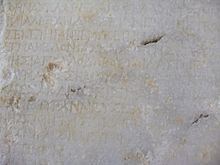 | ||
Similar Suda, Bibliotheca, Constitution of the Athenians, Catalogue of Women, Meteorology | ||
The Parian Chronicle or Parian Marble (Latin: Marmor Parium, Mar. Par.) is a Greek chronology, covering the years from 1582 BC to 299 BC, inscribed on a stele. Found on the island of Paros in two sections, and sold in Smyrna in the early 17th century to an agent for Thomas Howard, Earl of Arundel, this inscription was deciphered by John Selden and published among the Arundel Marbles, Marmora Arundelliana (London 1628-9) nos. 1-14, 59-119. The first of the sections published by Selden has subsequently disappeared. A further third fragment of this inscription, comprising the base of the stele and containing the end of the text, was found on Paros in 1897. It has entries from 336/35 to 299/98 BC.
The two known upper fragments, brought to London in 1627 and presented to Oxford University in 1667, include entries for the years 1582/81–355/54 BC. The surviving upper chronicle fragment currently resides in the Ashmolean Museum at Oxford. It combines dates for events we would consider mythic, such as the Flood of Deucalion (equivalent to 1529/28 BC) with dates we would categorize as historic. For the Greeks, the events of their distant past, such as the Trojan War (dated from 1217 to 1208 BC in the Parian inscription) and the Voyage of the Argonauts were historic: their myths were understood as legends to the Greeks. In fact the Parian inscriptions spend more detail on the Heroic Age than on certifiably historic events closer to the date the stele was inscribed and erected, apparently during 264/263 BC. "The Parian Marble uses chronological specificity as a guarantee of truth," Peter Green observed in the introduction to his annotated translation of the Argonautica of Apollonios Rhodios: "the mythic past was rooted in historical time, its legends treated as fact, its heroic protagonists seen as links between the 'age of origins' and the mortal, everyday world that succeeded it."
The shorter fragment base of the stele, found in 1897, is in a museum on Paros. It contains chronicle entries for the years 336/35–299/98 BC.
RTI scanning
In 2013, Ben Altshuler of the Institute for Digital Archaeology oversaw reflectance transformation imaging (RTI) of the Parian Marble, revealing significant, previously illegible text.
